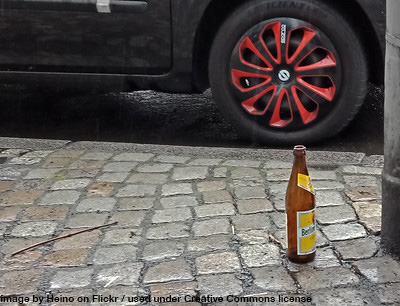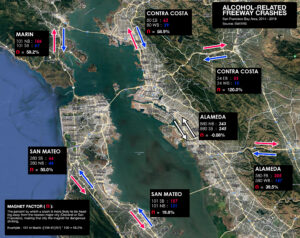
Mapping the Bay Area’s “magnets” for potential deadly drivers.
As the California Assembly debates the passage of SB 930, a poorly conceived and reckless bit of legislation that would extend last call times in certain cities, the question remains: what about the rest of us? What should we expect if we don’t live in these cities?
It’s clear from existing research that extended last call times are associated with increased violent crime, emergency room visits, ambulance calls, and DUIs. What’s also clear is that people who drink in one city often do not confine their driving to just that same city. According to Ventura County Behavioral Health, people receiving DUIs often travel 7 to 40 miles before getting pulled over. Surveillance in New York State showed that DUIs were elevated in counties whose neighbors had extended last call times, even if those counties kept to normal ones.
So if San Francisco extends its last call hours, what happens to the other communities in the area?
Alcohol Justice used the TIMS mapping system run by UC Berkeley to count alcohol-related freeway crashes among drivers coming into the major Bay Area metropolises of San Francisco and Oakland, and compare them to alcohol-related crashes leaving those cities. We then used those data to identify a “magnet factor,” looking at how much more likely a crash would be on the outbound side of the freeway. This would attempt to measure the degree to which San Francisco or Oakland serves as a “magnet” for drinkers, pulling them from surrounding communities then sending them back out across bridges and through tunnels, to cause crashes far away from the epicenter of the party.
FULL BAY AREA “MAGNET FACTOR” MAP
 The results were striking. 6 out of 7 freeways had a positive magnet factor (meaning crashes were more likely to be heading out of the major cities). The “magnet” effect ranged from nearly 20 in San Mateo on Hwy 101, to 120 in Contra Costa on Hwy 24. Most freeways (101 in Marin, 280 in San Mateo 580 in Alameda, 580/80 in Contra Costa) fell between 40 and 60—meaning it is 40% to 60% more likely that an alcohol-related crash was heading out of the closest major city. Only 880 in Alameda showed no effect, with nearly the same number of crashes in each direction.
The results were striking. 6 out of 7 freeways had a positive magnet factor (meaning crashes were more likely to be heading out of the major cities). The “magnet” effect ranged from nearly 20 in San Mateo on Hwy 101, to 120 in Contra Costa on Hwy 24. Most freeways (101 in Marin, 280 in San Mateo 580 in Alameda, 580/80 in Contra Costa) fell between 40 and 60—meaning it is 40% to 60% more likely that an alcohol-related crash was heading out of the closest major city. Only 880 in Alameda showed no effect, with nearly the same number of crashes in each direction.
To be fair, these are not place-of-last-drink studies, so we cannot know for sure where the drivers originated. However, absent another reason for the size and centrality of these imbalances, it creates compelling evidence that bar- and nightclub-dense, nightlife-oriented cities dump at least some of the harms on cities that do not receive any jobs, tourism, or tax revenue from those industries.
These are the areas where the cost-benefit balance for a policy change like SB 930 would be deeply negative. Even ignoring the fact that last call times are one of the major pillars of alcohol harm prevention, the impacts from policies like SB 930 simply would not remain contained. So long as we all live in this state together, we all take on the risks from alcohol deregulation.
READ MORE about the threat from extended last call times.
READ MORE about the potential costs to cities involved in extended last call legislation.
